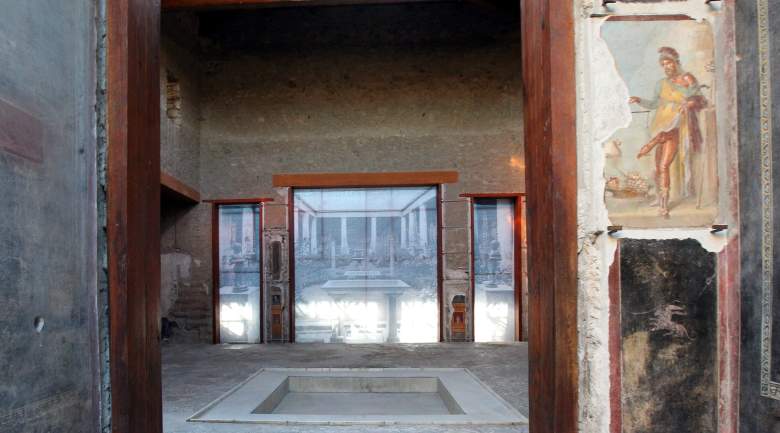
CARLO HERMANN/AFP/Getty Images)
British tourist Caprice Arnold has been accused by Italian authorities of attempting to steal historical artifacts from the ancient ruins of Pompeii. Attracting more than 2 million visitors annually, Pompeii is famous for being destroyed after the eruption of Mount Vesuvius in 79 AD that killed thousands of the city’s inhabitants.
Authorities claim that while on holiday, the British woman climbed over a security railing and chiseled off 20 tiles at the UNESCO World Heritage Site, placing three in her bag. The date of the incident has not been reported.
Here’s what you need to know about the Caprice Arnold incident at Pompeii.
1. Caprice Arnold Insists She’s Innocent
According to Arnold, she and her twin sister were celebrating their twenty-first birthday in Italy with their father and decided to pay a visit to Pompeii. During the visit, a security guard claims to have seen Arnold chisel off approximately 20 ancient mosaic tiles, take three and put them in her purse. When she was stopped and asked to fill out a report, Italian authorities said she ignored them and walked away. Immediately afterward, Arnold was detained by the police.
It’s reported that charges have been filed against Caprice Arnold for “aggravated damage.” On April 8, restoration experts began repairing the damaged mosaic. The cost of repairs is estimated at 3,000 euros ($3,400).
Arnold maintains her innocence, explaining to The Mirror that she “just bent down to inspect loose tiles,” and that the incident was just a “misunderstanding.” After being detained, Arnold was questioned by the police for two hours. “They have since said I had tiles and some kind of tool in my bag but that is 100% not true,” she told The Daily Mail. Arnold went on to say that she was never searched and that police failed to provide her with a translator.
Upon release, the Arnold family was told that a letter would be sent to them, however, the letter has yet to be received. Arnold’s father, Joey, believes his daughter innocent. “She’s lovely – you’d know that in a heartbeat if you met her,” he said. Caprice Arnold has told reporters that she expects to be fully exonerated.
Should Caprice Arnold’s case go to trial, there is a possibility of a fine and/or prison.
2. Caprice Arnold Was Apprehended at the Famed House of the Anchor
Authorities spotted Arnold scaling the security rail at the House of the Anchor, one of the most famous homes at the ancient historical site. The house is known for the mosaic tile anchor design at the front of the residence.
Historians believe the anchor was used to symbolize peace and stability. The home is known for having a unique layout with upper and lower levels as well as a garden. The site was originally excavated in 1826.
3. Pompeii Has a Tragic History
Pompeii is a historical destination that’s also an active archeological site located 150 miles south of Rome, in the Campagna region near Naples. Situated near the base of Mount Vesuvius, the ancient city was reduced to ash and rubble in on August 24, 79 AD when the deadly volcano erupted, showering lava and hot ash on the city, killing 2,000 of the city’s 20,000 residents so quickly that their remains were immediately hardened by the hot ash and their corpses appear to be frozen in time.
An eyewitness to the tragic event said the ash spewed from Mount Vesuvius “poured across the land” like a flood, one witness wrote, and shrouded the city in “a darkness…like the black of closed and unlighted rooms.”
Following the eruption the city was covered in tons of ash, making it nearly impossible for family and friends to locate loved ones. Soon after the eruption, Pompeii and the neighboring towns of Stabiae and Herculaneum were abandoned.
4. Pompeii Has Been Looted Repeatedly
Italy Has Been Called an “Art Theft Playground” and looting has happened in Pompeii over the last 2,000 years with regularity. Most recently, French tourist Pierre Luc Giglio, 52, was arrested in May 2018 for trying to smuggle out artifacts by stuffing them into his backpack. Guards stopped Giglio and a female companion after they began to act suspiciously. Upon inspection, Guglio was discovered with 13 pieces of terra cotta and a piece of marble thought to have been taken from the House of Loreius Tiburtinus, a villa thought to have been owned by one of Pompeii’s wealthier families.
In 2014, an American couple was nabbed at Rome’s Fiumicino Airport, where authorities caught them with a 65-pound artifact in their luggage. The two were arrested after airport security spotted the historical piece in their rental car.
Some thieves are using more sophisticated methods. In 2018 archaeologists discovered that modern-day tomb raiders who created elaborate tunnels under the city designed to smuggle antiquities out of the historical park. Authorities are uncertain how much loot the robbers were able to carry off.
While most of the items are taken as souvenirs or sold on the black market, some thieves have had a change of heart and returned stolen pieces. The Telegraph reports that curators have received hundreds of packages from guilty pilferers “expressing regret.” In 2018, a 70-year-old Canadian woman personally returned an artifact she’d stolen as a memento during her honeymoon fifty years earlier.
5. Some Thieves Return Stolen Artifacts Claiming They are Cursed
Some of Pompeii’s antiquities have been returned by superstitious robbers who believe that the stolen items are cursed. Legend’s blame the Roman gods for destroying the city due to a lack of respect and morals.
Pompeii’s Archeological Superintendent Massimo Osanna revealed to the Daily Mail that robbers send remorseful notes explaining that the stolen items have brought “nothing but trouble,” and that “they say they can trace back all their family troubles to their theft at Pompeii.”